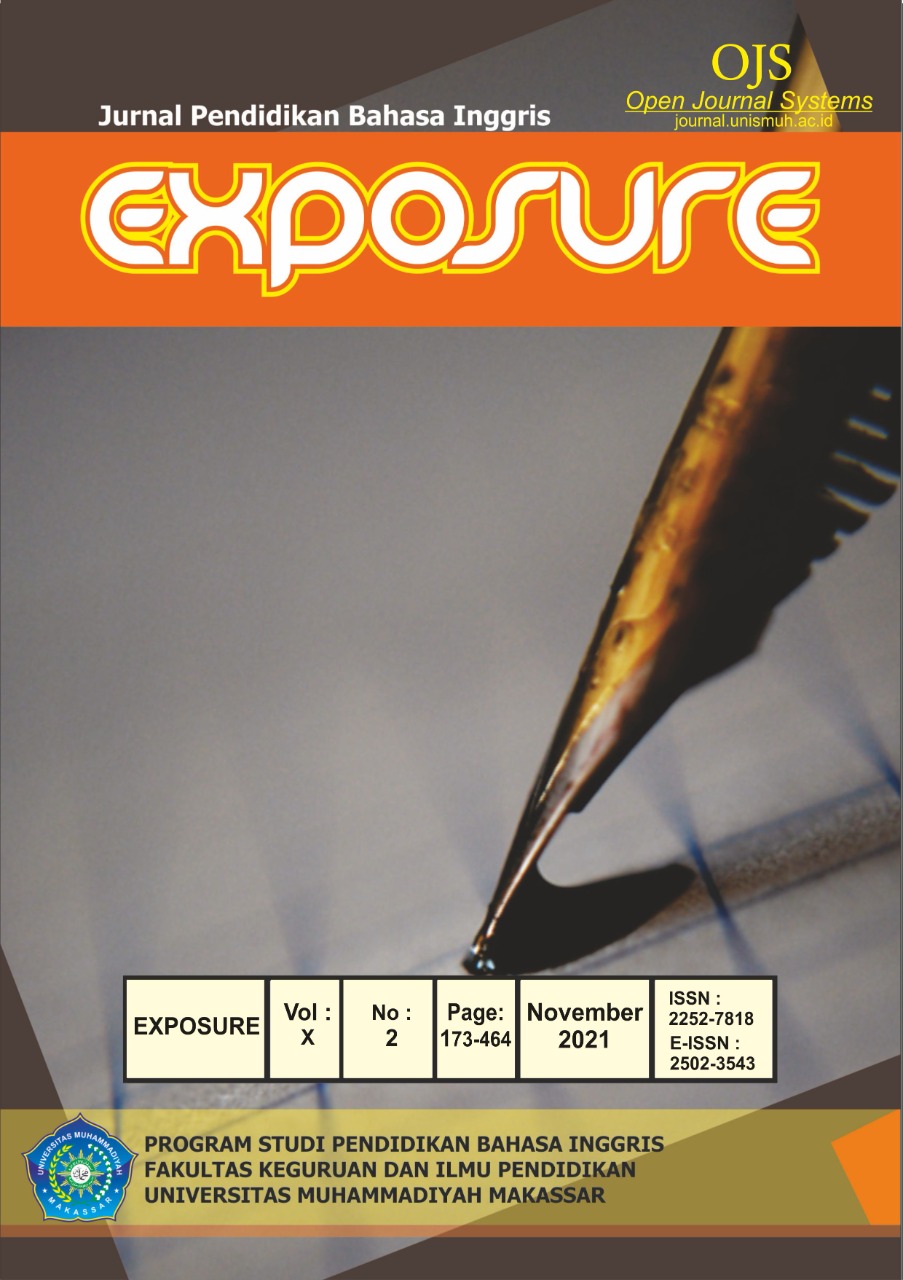IMPROVING STUDENTS READING SKILL IN UNDERSTANDING FUNCTIONAL PROCEDURE AND REPORT TEXTS THROUGH SCANNING TECHNIQUES AT JUNIOR HIGH SCHOOL
DOI:
https://doi.org/10.26618/exposure.v10i2.5483Keywords:
Functional Text, Procedure, Report, Scanning Reading.Abstract
This study aims to improve the skills of understanding the meaning of context in procedure and report functional texts through the scanning reading technique of class IX SMP Negeri 9 Makassar. This research approach, which is descriptive. The design or model of this research is Action Research. The subjects of the study were 23 students of class IX SMP Negeri 9 Makassar State Vocational High School. Data collection is done through observation, documentation, and test techniques. Data analysis techniques, namely quantitative descriptive analysis and qualitative descriptive analysis. The results showed that scanning reading techniques can improve students' ability to understand the meaning of context in procedure and report functional texts are very high and increase from the low category to high with the average value of the first cycle is 56.52 and increases in the second cycle to 82.82. Changes and improvements also appear in the achievement of learning completeness from 21.73% in the first cycle to 100% in the second cycle. The scanning reading technique can increase student activity. In the first cycle, the activity of students was categorized as less and increased in the second cycle to be a very active category. Student interest and motivation increases in understanding procedure and report functional texts, on average students focus attention on learning to understand functional procedure and report texts, the average student is active in learning to understand functional procedure and report texts, and the average value of students from aspects of knowledge and psychomotor reach KKM.
References
Alam, Syamsu.(2008). Peningkatan Kemampuan Memahami Isi Bacaan dengan Menggunakan Strategi Pandangan Periferi Siswa Kelas Khusus Lembaga Penjaminan Mutu Pendidikan Sul-Sel. Tesis.: Pascasarjana UNM.
Alwi, Hasan dkk.(1997). Kamus Besar Bahasa Indonesia Edisi III. Balai Jakarta: Pustaka.
Zainal,Aqib.(2006). Penelitian Tindakan Kelas. Yrama Widaya: Bandung.
Arikunto, Suharsimi.(2008). Penelitian Tindakan Kelas. Jakarta: Bumi Angkasa.
Djumingin, Sulastriningsih.(2002). Strategi Belajar Mengajar. Diktat. : FBS UNM.
Djumingin, Sulastriningsih.(2007).’’Pengajaran Prosa Fiksi dan Drama. Diktat. : FBS UNM.
Kunandar.(2008). Langkah Mudah Penelitian Tindakan Kelas. Jakarta: Rajagrafindo Persada.
Kemendikbud.(2013). Kurikulum 2013. Jakarta: Kemendikbud.
Nurgiyantoro, Burhan.(1987). Penilaian Dalam Pengajaran Bahasa dan Sastra. Yogyakarta: BPFE.
Nurhadi.(2005). Bagaimana Meningkatkan Kemampuan Membaca?. Bandung: Sinar Baru Algensindo.
Nurhadi.(2005). Membaca Cepat dan Efektif. Bandung: Sinar Baru Algensindo.
Rahim, Farida.(2008). Pengajaran Membaca di Sekolah Dasar. Jakarta: Bumi Aksara.
Soedarso.(2006). Speed Reading Sistem Membaca Cepat dan Efektif. Jakarta: Gramedia.
Sugiyono.(2008). Metode Penelitian Pendidikan. Bandung: Alfabeta.
Tarigan, Henry Guntur.(2008). Membaca Sebagai Suatu Keterampilan Berbahasa. Bandung: Angkasa.
Wainwright, Gordon.(2007). Speed Reading Better Recalling. Jakarta: Gramedia.
Downloads
Published
Issue
Section
License
Authors who publish with this journal agree to the following terms:
In order to assure the highest standards for published articles, a peer review policy is applied. In pursue of the compliance with academic standards, all parties involved in the publishing process (the authors, the editors and the editorial board and the reviewers) agree to meet the responsibilities stated below in accordance to the Journal publication ethics and malpractice statement.
Duties of Authors:
- The author(s) warrant that the submitted article is an original work, which has not been previously published, and that they have obtained an agreement from any co-author(s) prior to the manuscript’s submission;
- The author(s) should not submit articles describing essentially the same research to more than one journal;
- The authors(s) make certain that the manuscript meets the terms of the Manuscript Submission Guideline regarding appropriate academic citation and that no copyright infringement occurs;
- The authors(s) should inform the editors about any conflict of interests and report any errors they subsequently, discover in their manuscript.
Duties of Editors and the Editorial Board:
- The editors, together with the editorial board, are responsible for deciding upon the publication or rejection of the submitted manuscripts based only on their originality, significance, and relevance to the domains of the journal;
- The editors evaluate the manuscripts compliance with academic criteria, the domains of the journal and the guidelines;
- The editors must at all times respect the confidentiality of any information pertaining to the submitted manuscripts;
- The editors assign the review of each manuscript to two reviewers chosen according to their domains of expertise. The editors must take into account any conflict of interest reported by the authors and the reviewers.
- The editors must ensure that the comments and recommendations of the reviewers are sent to the author(s) in due time and that the manuscripts are returned to the editors, who take the final decision to publish them or not.
Authors are permitted and encouraged to post online a pre-publication manuscript (but not the Publisher’s final formatted PDF version of the Work) in institutional repositories or on their Websites prior to and during the submission process, as it can lead to productive exchanges, as well as earlier and greater citation of published work (see The Effect of Open Access). Any such posting made before acceptance and publication of the Work shall be updated upon publication to include a reference to the Publisher-assigned DOI (Digital Object Identifier) and a link to the online abstract for the final published Work in the Journal.

